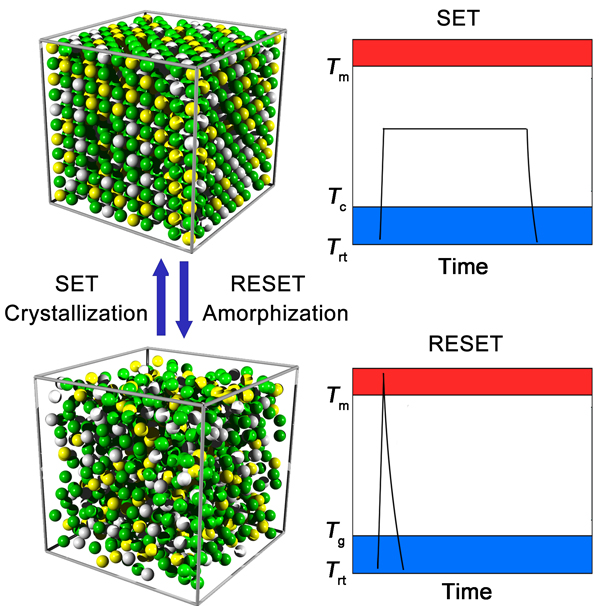Recording information has been one of the most important issues since the beginning of human civilization. The demand for data storage is growing constantly with time and explosively in the era of information. The current non-volatile data storage market has been dominated by Silicon-based Flash memory, however, such technology seems to have reached its maximum capacity due to simple quantum mechanical considerations. Tremendous efforts have been undertaken to develop new data storage and memory technologies. Up to now, several promising candidates, such as PCM, RRAM, MRAM, FeRAM and so on, are under investigation and development as possible more scalable replacements for Flash.
Phase-change memory materials:
Phase-change materials (PCM) based memory technology (PRAM) [1] has drawn great attentions in recent years and has been considered to be one of the most promising candidates for the next-generation data storage and memory technologies. A universal memory can be built based on PCM to replace magnetic hard drives, Flash memory and DRAM. The working principle of PRAM is to generate two stable solid states with significant conductivity contrast, which can be detected and marked as different logic states. Moreover, the transitions between the two states are typically reversible and fast; and the storage units can be scaled down to a few nanometers. We are interested in fundamental research on PCMs, including structural and electronic properties of complex solids and glass [2, 3]; crystallization kinetics [4]; nanoparticles and nanowires; multi-level data storage [2]; design of new PCMs and new phase change mechanisms, phase change control [5, 6], etc. Our investigations will further boost the applications of PCMs.

References:
1. M. Wuttig & N. Yamada. Phase-change materials for rewriteable data storage. Nature materials 6, 824-832 (2007).
2. W. Zhang, A. Thiess, P. Zalden, R. Zeller, P.H. Dederichs, J.Y. Raty, M. Wuttig, S. Blugel & R. Mazzarello. Role of vacancies in metal-insulator transitions of crystalline phase-change materials. Nature materials 11, 952-956 (2012).
3. V. Deringer, W. Zhang, M. Lumeij, S. Maintz, M. Wuttig, R. Mazzarello & R. Dronskowski. Bonding nature of local structural motifs in amorphous GeTe. Angew Chem Int Ed 53, 10817-10820 (2014).
4. W. Zhang, I. Ronneberger, P. Zalden, M. Xu, M. Salinga, M. Wuttig & R. Mazzarello. How fragility makes phase-change data storage robust: insights from ab initio simulations. Scientific reports 4, 6529 (2014).
5. W. Zhang, I. Ronneberger, Y. Li & R. Mazzarello. Magnetic properties of crystalline and amorphous phase-change materials doped with 3d impurities. Adv Mater 24, 4387-4391 (2012).
6. W. Zhang, I. Ronneberger, Y. Li & R. Mazzarello. Ab initio investigation of crystalline and amorphous GeTe doped with magnetic impurities. Sci Adv Mater 6, 1655 (2014).

